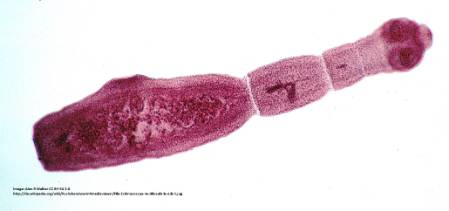Intestinal schistosomiasis, caused by Schistosoma mansoni, is endemic to Lake Victoria, with high prevalence of the disease in human lakeshore communities. Schistosomiasis caused by S. mansoni and a number of other species affects over 200 million people worldwide and is classified by the World Health Organisation as a Neglected Tropical Disease, associated with poverty and limited access to public health services.
Schistosoma mansoni is a trematode worm, related to flukes, and is the focus of research by a number of NHM research scientists. Understanding the life-cycle (part of which takes place in a snail vector, Biomphalaria) and evolution of the parasite is essential to enable effective disease control to be put in place. Intestinal schistosomiasis causes a range of debilitating chronic health problems, including organ damage, which contribute to a low quality of life for those affected.

A scanning electron microscope image of male and female Schistosoma mansoni
Although research has led to much better understanding of the life-cycle, nonhuman primates have until recently been overlooked as potential hosts of the disease, despite known susceptibility. NHM PhD student Claire Standley is lead author on a new study, with Russell Stothard and Richard Kane (Zoology) and other co-authors, that has looked at transfer of the parasite between chimps and humans.
They examined 39 semi-captive wild-born chimpanzees being cared for at Ngamba Island Chimpanzee Sanctuary, Lake Victoria, Uganda, together with 37 staff members for S. mansoni infection. Miracidia (a life stage of the parasite) recovered from faeces were analysed for DNA to investigate cross-over between humans and chimpanzees.The island was also surveyed for Biomphalaria intermediate host snails, which were examined for infection with S. mansoni.
Chimpanzees were unequivocally shown to be infected with intestinal schistosomiasis. Miracidia hatched from chimpanzee faeces revealed three S. mansoni DNA profiles (haplotypes) commonly found in humans living throughout Lake Victoria, including staff on Ngamba Island, as well as two previously undescribed haplotypes. At one site, a snail was observed shedding schistosome cercariae (another life stage of the parasite that is released into water and that enters humans through the skin).
The scientists concluded that the potential for transfer of intestinal schistosomiasis between humans and animals on Ngamba Island is greater than previously thought. In addition, chimpanzees were excreting schistosome eggs that were capable of hatching into viable miracidia. This suggests that these nonhuman primates may be capable of maintaining a local reservoir of schistosomiasis independently of humans - which in turn means that control strategies focused only on treating the parasite in humans may not be successful: account needs to be taken of possible persistence of schistosomes in animal populations.
Claire J. Standley, Lawrence Mugisha, Jaco J. Verweij, Moses Adriko, Moses Arinaitwe, Candia Rowell, Aaron Atuhaire, Martha Betson, Emma Hobbs, Christoffer R. van Tulleken, Richard A. Kane, Lisette van Lieshout, Lilly Ajarova, Narcis B. Kabatereine, J. Russell Stothard. Confirmed Infection with Intestinal Schistosomiasis in Semi-Captive Wild-Born Chimpanzees on Ngamba Island, Uganda.Vector-Borne and Zoonotic Diseases. February 2011, 11(2): 169-176. doi:10.1089/vbz.2010.0156.




